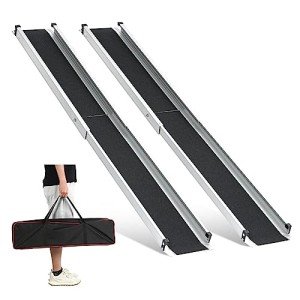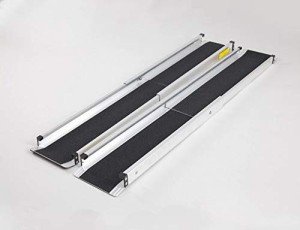In today's world, accessibility is recognized as a fundamental right for everyone, including individuals with mobility challenges. Wheelchair ramps play a crucial role in providing this accessibility, enabling users to navigate varying heights with ease. Among the many options available, adjustable telescopic wheelchair ramps have become increasingly popular for their versatility and adaptability. This guide will explore the features, advantages, and considerations of adjustable telescopic wheelchair ramps, specifically those ranging from 6ft to 12ft in length.
What Are Adjustable Telescopic Wheelchair Ramps?
Adjustable telescopic wheelchair ramps are specially designed mobility aids that can be extended or retracted to accommodate different heights and requirements. Unlike traditional ramps that have a fixed incline and length, these ramps offer users the ability to adjust the ramp’s length according to the specific elevation they need to conquer.
Key Features
-
Length Adjustment: Ramps can extend between 6ft and 12ft, making them suitable for a wide variety of applications, from curbs to stairs.
-
Lightweight Materials: Most telescopic ramps are crafted from durable yet lightweight materials, which facilitate easy transport and setup.
-
Compact Design: When retracted, these ramps take up minimal space, making them ideal for storage and transportation in vehicles.
-
Non-Slip Surface: Many models come with a textured surface to provide additional grip for wheelchairs, scooters, or feet, even in wet conditions.
-
Safety Features: High-quality models often include side rails and safety straps to secure the ramp to the vehicle or surface, enhancing safety during use.
Benefits of Using Adjustable Telescopic Wheelchair Ramps
- Versatility: Their adjustable nature makes them suitable for various settings, including homes, offices, and public spaces.
- Ease of Use: With minimal setup, an individual can quickly extend or retract the ramp as needed, which is particularly useful for caregivers and users alike.
- Increased Mobility: Users can access previously inaccessible areas, promoting independence and improving quality of life.
- Cost-Effectiveness: Adjustable ramps can replace multiple fixed ramps, resulting in savings on equipment costs.
- Enhanced Safety: By using a ramp suitable for the height in question, the risks of accidents associated with steep or poorly constructed inclines are minimized.
Choosing the Right Adjustable Telescopic Wheelchair Ramp
Selecting the appropriate adjustable ramp involves considering various factors. Below are essential aspects to keep in mind:
1. Ramp Length
- 6ft Ramps: Ideal for minor obstacles, such as low steps or curbs.
- 8ft Ramps: Suitable for slightly higher areas, providing a good balance between steepness and length.
- 12ft Ramps: Best for accessing higher platforms, ensuring a gentler incline for easy navigation.
2. Weight Capacity
Always check the manufacturer's specifications for weight limits. Most telescopic ramps can support between 600 and 800 pounds, but it’s crucial to choose one that meets specific individual needs.
3. Material
Opt for ramps made from aluminum or similar materials that offer both strength and lightweight properties. A good ramp should resist rust and corrosion, especially if used outdoors.
4. Portability
If portability is essential, ensure the ramp is lightweight and comes with carrying handles. Some designs fold into a compact size, making them easier to store and transport.
5. Specialized Features
Some ramps come with additional features such as:
- Adjustable height settings
- Foldable designs
- Built-in safety rails
- Carrying bags for easy transport
Installation Guidelines
Setting up an adjustable telescopic wheelchair ramp is generally straightforward, but it's crucial to follow best practices to ensure safety and functionality:
- Determine the Height: Measure the height of the threshold or platform to ensure the selected ramp length is appropriate.
- Set an Appropriate Angle: A general guideline is to maintain a slope of 1:12 (1 inch of rise per foot of ramp) for optimal safety and accessibility.
- Secure the Ramp: Use safety straps or pins to fix the ramp in place, minimizing movement during use.
- Check Stability: Before using the ramp, make sure it is stable and properly positioned.
FAQs
What is the maximum incline for a wheelchair ramp?
The maximum recommended incline is a 1:12 ratio, meaning for every inch of vertical rise, there should be at least 12 inches of ramp run. More gradual slopes are preferable for a smoother and safer transition.
Can telescopic ramps be used for other mobility devices?
Yes! Adjustable telescopic ramps are suitable for wheelchairs, mobility scooters, and other assistive devices, provided the weight limits are adhered to.
How do I maintain my telescopic ramp?
Regularly inspect the ramp for cracks, rust, and loose bolts. Clean the surface with mild detergent and avoid harsh chemicals to prevent deterioration.
Are there specific ramps for vehicles?
Yes, there are telescopic ramps specifically designed for use with vehicles, offering added features like wheel chocks and higher weight capacities to accommodate the heavier load of wheeled transport.
What is the average price range for adjustable telescopic wheelchair ramps?
Pricing can vary based on materials, length, and features, generally ranging from £150 to £500. Higher-end models equipped with specialized features may cost more.
Adjustable telescopic wheelchair ramps provide a vital service in fostering accessibility and independence for individuals with mobility challenges. With lengths varying from 6ft to 12ft, these ramps are adaptable, practical, and user-friendly. When selecting a ramp, potential users should consider factors such as length, weight capacity, material, and individual needs to ensure maximum safety and performance. By taking the necessary precautions and utilizing quality ramps, individuals and caregivers can significantly enhance day-to-day mobility, reflecting a step toward greater inclusivity in society.







